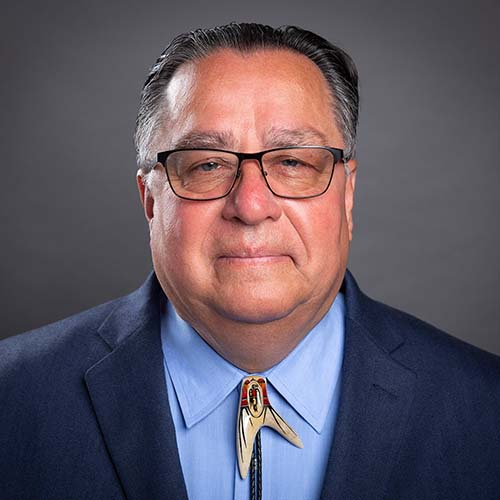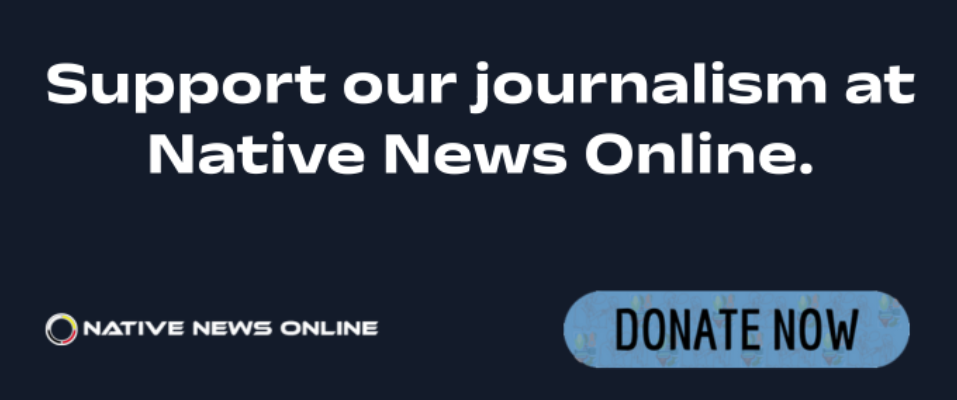
- Details
- By Chickasaw Nation Media
The Chikasha Academy Adult Immersion Program (CAAIP) graduated four students recently in a ceremony conducted in the Chickasaw Cultural Center’s Anoli’ Theater in Sulphur, Oklahoma.
The 2025 graduates are Sinti' Elias Brown, Faithlyn Taloa Seawright, Palhkitabi' Jason Morgan, and Chokfi' Briana Mason.
Lokosh (Joshua D. Hinson, Ph.D.), executive officer of language preservation division in the department of culture and humanities, said four fundamental values undergird the foundation of the tribe’s language revitalization program.
“My hope is that you all will hold these values, remember them, speak them aloud, and derive strength and comfort from them as you move forward as anompa’ shaali’ (one who carries the language),” Lokosh encouraged graduates.
He said the core values are Chikasha poya (We are Chickasaw), Iilhakó'ffi (We survive), Ilachónna'chi (We persevere) and Iláyya'vsha katihma (We are still here).
Lokosh said Chickasaw values derive from ancestral knowledge and ways of being in such a way as to “help inform our understandings of our ancestors’ historical contexts and our own.”
He said the language revitalization work began at the behest of Chickasaw Nation Governor Bill Anoatubby in 2007 as a master-apprentice program until 2015. It transitioned in 2021 to the current CAAIP.
Lokosh credited those who had previously experienced a language revival with providing a foundation for the program’s course of study.
“We simply stood on the shoulders of giants who had come before us, namely the Salish language advocates from multiple tribal communities in the United States and Canada,” he said.
Lokosh lauded original Chickasaw language speakers both living and deceased with their contributions to the program’s successful implementation.
“We offer our gratitude to all members of the Chickasaw Language Committee, the late Stanley Smith, the late Phyllis Lattie, the late Dorothy Green, the late Vera Tims, the late Leerene Frazier, the late Weldon Fulsom, the late Catherine Willmond, the late Pauline Brown, the late Sam Johnson, the late Ruby James Harner and the late Hannah John.”
He expressed his appreciation to those who made direct contributions working with the graduates through the difficult learning process.
“With the support of Governor Bill Anoatubby and Secretary of Culture and Humanities Lisa John, led by Itti' Okchamali' Ric Greenwood under the direction of Kowishto' Clovis Hamilton, with mentoring and guidance from Osto Luther John, and following the curriculum created by Dr. Juliet Morgan, our graduates have successfully completed a three-year course of study in the Chikasha Academy Adult Immersion Program.”
Lokosh encouraged graduates to keep the four foundational principles uppermost in their minds.
“Graduates, think on this message and the words that I have shared with you today,” he said.
“Commit them to your minds. Write them on your hearts. Feel them in your throats. As you walk forward as anompa'shaali', speak them aloud and recall to mind those that went before, who sacrificed so dearly that we can stand today and say, in our language:
“Chikasha poya. We are Chikasha. Iilhakóffi. We survive. Ilachónna'chi. We persevere. Iláyya'sha katihma. We are still here. Chikasha po'yacha iláyya’sha katihmakat lhakóffit ilachónna'chi bílli'ya’shki. We are Chikasha, we are still here and, having survived, we will persevere forever.”
It is estimated fewer than three dozen original Chickasaw language speakers are alive today to pass on their linguistic knowledge to the next generation.
The CAAIP is just one of many tools available through the language preservation division.
Rosetta Stone Chickasaw was created at Governor Anoatubby’s direction to ensure all Chickasaws could have access to high quality, compelling language learning products.
Videos featuring native speakers of Chickasaw are available on the Chickasaw Nation Culture & Humanities YouTube page, as well as on Chickasaw.tv.
The first Chickasaw dictionary, authored by the Rev. Jesse Humes and Vinnie May Humes, and published in 1973, is now a website with embedded audio accessible at AChickasawDictionary. com. The language also has a presence on social media, including Instagram and X.
Other local community-based resources include Chipota Chikashshanompoli (Children Speaking Chickasaw) Language Club, four semesters of Chickasaw offered at East Central University and a language pilot project at Byng and Ada high schools, among other language-related services.
More Stories Like This
Native News Weekly (August 25, 2024): D.C. BriefsUS Presidents in Their Own Words Concerning American Indians
Navajo Man Faces Vehicular Homicide Charge After Child Killed at Navajo Nation Christmas Parade
Next on Native Bidaské: Lumbee Tribal Chairman John Lowery
Suspected Drunk Driver Crashes into Parade in Kayenta on Navajo Nation, Killing 1 & Injuring 3 Others
Help us defend tribal sovereignty.
At Native News Online, our mission is rooted in telling the stories that strengthen sovereignty and uplift Indigenous voices — not just at year’s end, but every single day.
Because of your generosity last year, we were able to keep our reporters on the ground in tribal communities, at national gatherings and in the halls of Congress — covering the issues that matter most to Indian Country: sovereignty, culture, education, health and economic opportunity.
That support sustained us through a tough year in 2025. Now, as we look to the year ahead, we need your help right now to ensure warrior journalism remains strong — reporting that defends tribal sovereignty, amplifies Native truth, and holds power accountable.
 The stakes couldn't be higher. Your support keeps Native voices heard, Native stories told and Native sovereignty defended.
The stakes couldn't be higher. Your support keeps Native voices heard, Native stories told and Native sovereignty defended.
Stand with Warrior Journalism today.
Levi Rickert (Potawatomi), Editor & Publisher

